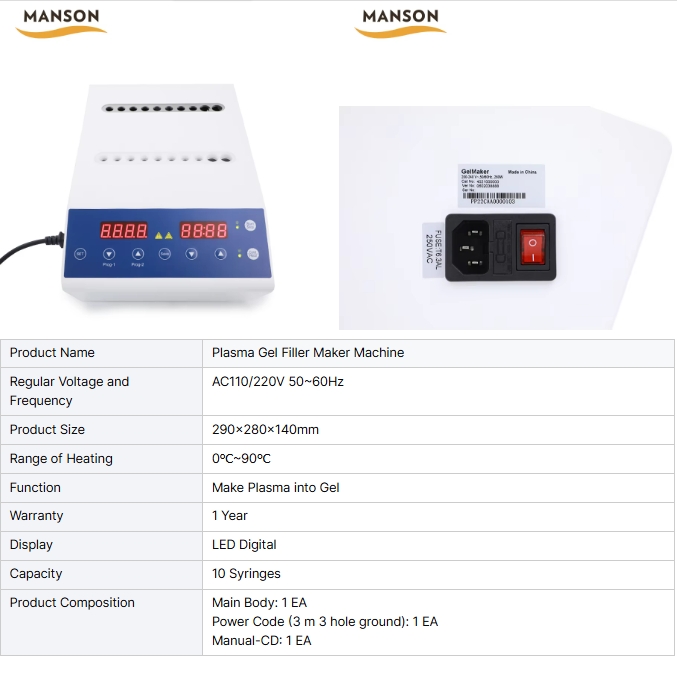PRP Portable Plasma Gel Machine Heating Gel Maker Function
What is PRP Plasma Gel?
- PRP (Platelet-Rich Plasma) is obtained by centrifuging a patient’s blood to isolate the plasma rich in platelets.
- When PRP is heated at a controlled temperature, it transforms into a gel-like substance, which can be used for:
- Tissue regeneration
- Dermal fillers in aesthetic treatments
- Wound healing and scar reduction
- Joint and tendon repair

The Manson PRP Plasma Gel Making Heating Machine is a specialized device used in medical and aesthetic procedures to prepare Platelet-Rich Plasma (PRP) gel. PRP gel is created by heating PRP derived from a patient’s blood to form a gel-like substance. This gel is often used in regenerative medicine, cosmetic treatments, and wound healing due to its rich concentration of growth factors and proteins.
Below is an overview of the machine, its features, and its applications:
The Manson PRP Plasma Gel Making Heating Machine is designed to:
- Heat PRP at precise temperatures to create a stable gel.
- Ensure the gel retains its biological properties, such as growth factors and cytokines.
- Provide a safe, sterile, and efficient process for medical professionals.
Key Features of the Manson PRP Plasma Gel-Making Heating Machine
- Temperature Control:
Precise temperature regulation (typically between 70°C to 90°C, depending on the protocol) to ensure proper gel formation without damaging the PRP’s bioactive components.
Digital display for monitoring and adjusting temperature. - Timer Function:
Built-in timer to control heating duration, ensuring consistent results.
It prevents overheating, which could degrade the PRP. - Compact and Portable Design:
Lightweight and easy to use in clinical or aesthetic settings.
Suitable for small clinics or mobile practitioners. - Sterility and Safety:
Made with materials that are easy to clean and sterilize.
Ensures compliance with medical safety standards. - User-Friendly Interface:
Simple controls for temperature and time settings.
Clear indicators for operation status. - Capacity:
Typically designed to accommodate multiple PRP tubes (e.g., 5-10 tubes) for batch processing.
Compatible with standard PRP tubes used in centrifugation. - Energy Efficiency:
Low power consumption, making it cost-effective for frequent use.
Applications of PRP Plasma Gel
- Aesthetic Medicine:
Used as a natural filler for facial rejuvenation, wrinkle reduction, and volume restoration.
Enhances skin texture and elasticity. - Regenerative Medicine:
Promotes tissue repair in chronic wounds, burns, and ulcers.
It supports healing in orthopedic treatments (e.g., joint injuries and tendonitis). - Hair Restoration:
PRP gel is sometimes combined with hair transplant procedures to stimulate hair growth. - Dental and Oral Surgery:
Used in bone grafting and tissue regeneration for dental implants.
How to Use the Manson PRP Plasma Gel-Making Heating Machine
- Prepare PRP:
Collect blood from the patient and centrifuge it to isolate PRP using a PRP centrifuge. - Load PRP Tubes:
Transfer the PRP into compatible tubes and place them in the heating machine. - Set Temperature and Time:
Adjust the temperature (usually around 75°C to 85°C) and set the timer (typically 5-15 minutes, depending on the protocol). - Start Heating:
Activate the machine and allow it to heat the PRP until it forms a gel. - Cool and Use:
Allow the gel to cool slightly before applying it to the treatment area.
Advantages of Using the Manson PRP Plasma Gel-Making Heating Machine
Consistency: Ensures uniform gel formation for reliable results.
Efficiency: Saves time compared to manual heating methods.
Safety: Reduces the risk of overheating or contamination.
Versatility: Suitable for various medical and aesthetic applications.
Precautions and Considerations
- Follow Manufacturer Guidelines:
Adhere to the recommended temperature and time settings to avoid damaging the PRP. - Sterilization:
Ensure all tubes and equipment are sterile to prevent infection. - Patient Safety:
Confirm that the patient is a suitable candidate for PRP therapy.
Monitor for any adverse reactions during or after treatment. - Maintenance:
Regularly clean and calibrate the machine to ensure optimal performance.

